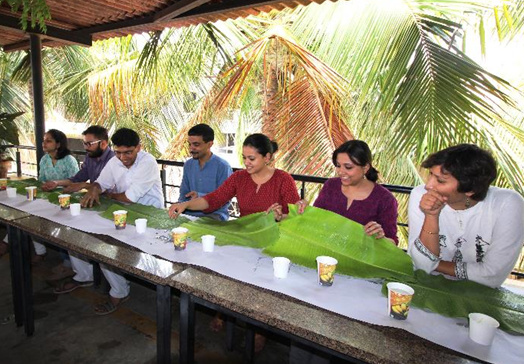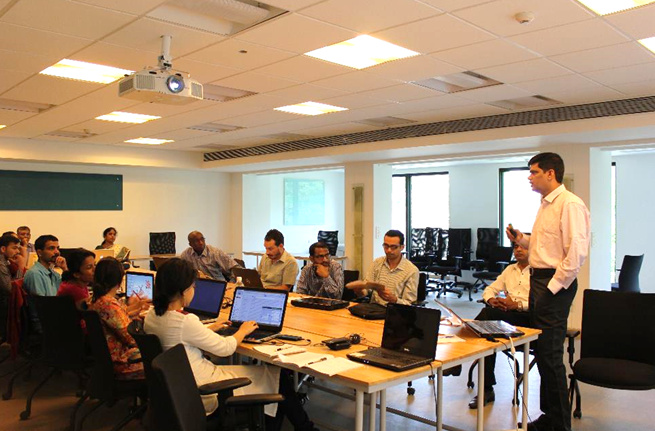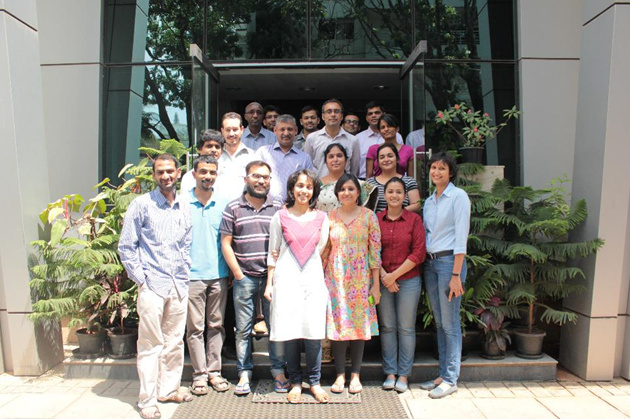ASSAR's South Asia team organises AgMIP training with West African support
By Andaleeb Rahman, Milind Bunyan, Chandni Singh, and P.C.S. Traore
Disciplines cutting across the physical and social sciences typically consider climate change and its associated impacts using discipline-specific tools. A trans-disciplinary and systems-based approach for modelling agricultural systems has been infrequently used. The Agricultural Model Intercomparison and Improvement Project (AgMIP) is a major international initiative, which has linked and improved various climate, crop, and economic models of agricultural systems in an innovative approach called Regional Integrated Assessments (RIAs) to quantify the likely biophysical and socio-economic impacts on the agricultural sector under various climate projections. The three core questions that these models attempt to answer are: (i) what is the level of sensitivity of current agricultural production systems to climate change?; (ii) how will climate change impact future agricultural production systems?; and (iii) what are the benefits of climate change adaptations?
To leverage the strengths of the AgMIP initiative in our chosen transects, ASSAR-South Asia organized a training program at the Indian Institute of Human Settlements (IIHS), Bengaluru from 31st March-7th April 2015. The course was anchored by Amir Bazaz from IIHS and Pierre C. Sibiry Traoré from the International Crops Research Institute for the Semi-Arid Tropics (ICRISAT), with experts from the Tamil Nadu Agricultural University (TNAU), Coimbatore and Initiative Prospective Agricole et Rurale (IPAR), Senegal assisting the training. The workshop was attended by the ASSAR team at IIHS and our partners Ashoka Trust for Research in Ecology and Environment (ATREE), Bengaluru, and Watershed Organisation Trust (WOTR), Pune. ASSAR and AgMIP share a common geographical and thematic interest in Semi-Arid regions, particularly in South Asia and West Africa.
The workshop provided hands-on training and introduced participants to the use of AgMIP tools. The first day of the workshop was held at the IIHS campus where Sibiry Traoré briefed the participants on the need for a trans-disciplinary, systems-based approach for integrated modelling of climate change impacts on agricultural systems. This was followed by a discussion on the utility of AgMIP tools in answering the research questions that ASSAR-South Asia hopes to answer. On the second day of the workshop (held at ATREE), participants learnt how to generate location-specific climate data using the statistical platform R. For the Moyar-Bhovani sub-region, location-specific data were developed from the nearest climate station (i.e. Coimbatore). These exercises were a valuable learning experience for the participants as they were taught how to use and modify R scripts to generate current and future climate under various climate scenarios. The participants also enjoyed an Ugadi (harvest festival in the state of Karnataka) feast.

ASSAR team members enjoying an Ugadi feast at ATREE (Photo: Jayalakshmi Krishnan, ATREE)
On the third day the workshop (held at IIHS), Prof. V. Geethalakshmi and Dr. A Lakshmanan from TNAU contextualized the application of AgMIP tools by drawing on their work in South India which assessed the impacts of climate change and climate variability on agricultural production systems and, importantly, on farm household income and food security. They also presented their plans to simulate agricultural productivity and impacts on crop production under different management systems and climate change scenarios using hydrological and crop models, integrated with the climate model outputs. Finally, they discussed the current comprehensive assessment of impacts, vulnerabilities and adaptation options for South India undertaken within the AgMIP framework. On the same day, Dr. Kadiyala Dakshinamurthy (ICRISAT, Hyderabad) led us through the use of AgMIP data translation tools to automate ensemble crop model simulations with the Decision Support System for Agrotechnology Transfer (DSSAT), and the Agricultural Production Systems SIMulator (APSIM) using example data from Nioro, Senegal.
The next day began with a detailed introduction to the use of the TOA-MD (Trade-off Analysis- Multi-Dimensional) and Representative Agricultural Pathways (RAPs) by Prof. P. Paramasivam (TNAU). Prof. Paramasivam described the process of developing a RAP and its utility in visualizing different future pathways for a given agro-ecosystem. The RAPs for a system can then be interrogated in terms of their underlying assumptions and incorporate existing expert opinions to develop potential adaptation strategies.
Dr. Ibrahim Hathie (IPAR, Senegal) then conducted a hands-on session on the use of ToA-MD, which can be described as a meta-analysis modelling tool that uses outputs from different models (e.g. APSIM, DSSAT) constrained for future systems by quantitative trends set up in the RAPs. ToA-MD are used in AgMIP to determine the sustainability of agricultural systems under various climate and socio-economic scenarios, thus informing policy decisions. The utility of these models is enhanced by the minimal amount of information required to provide the trade-off for various adaptation practises. Dr. Ibrahim Hathie used the example data from Nioro (Senegal) to demonstrate the workings of the model under different adaptation options.

Above: Dr. Dakshina Murthy from ICRISAT giving an overview of crop models
Dr. Sibiry Traoré (ICRISAT, Mali) spearheaded the last two days of the workshop, with one break-out group focusing on developing a conceptual RAP for the Moyar-Bhavani sub-region, and the other breakout group dedicating their efforts to conceptualizing and adapting the RAP methodology for the urban Bangalore sub-region. Brainstorming over two days helped the teams to develop likely scenarios for the two sub-regions and these were presented to the rest of the team for feedback and discussion.
Overall, the training was an interesting exercise in bringing together a diverse range of researchers to explore how modelling approaches can help develop adaptation scenarios. One way we envision this moving forward is using the scenario outputs to support ASSAR’s Transformative Scenario Planning (TSP) exercise. Second, using AgMIP tools, which are primarily developed for agricultural systems, in an urban setting like Bangalore city, offers a novel cross-fertilisation of methodological approaches: Representative Urban Systems (RUPs) were proposed as an analogous framework to RAPs, within which adaptation tradeoffs may be simulated across heterogeneous (peri)-urban districts and their rural hinterland, using different classes of functional models of land use and other planning practises, and with a particular focus on improving water-use efficiency in the face of climate change. AgMIP, which aims to strengthen stakeholder involvement in its second phase (2015-2016) might benefit from the TSP exercise and from linkages to the policy design and Research-into-Use (RiU) opportunities presented by ASSAR.

Above: Participants of the AgMIP training at IIHS, Bengaluru